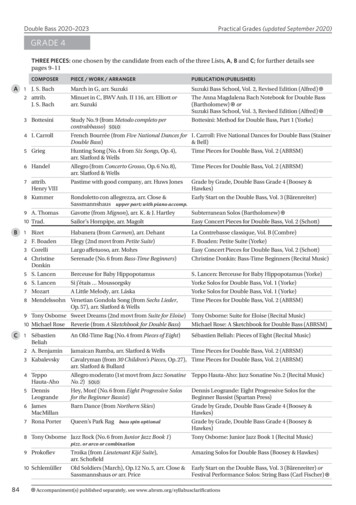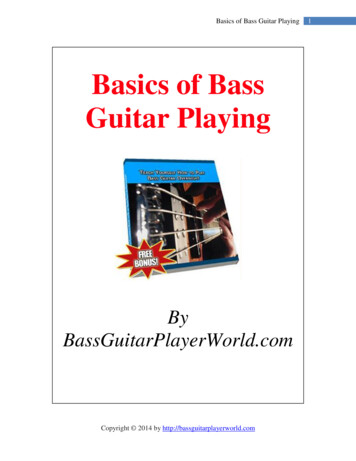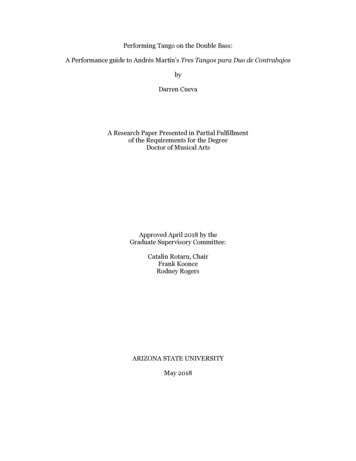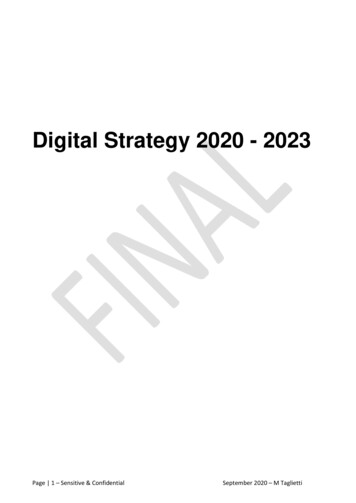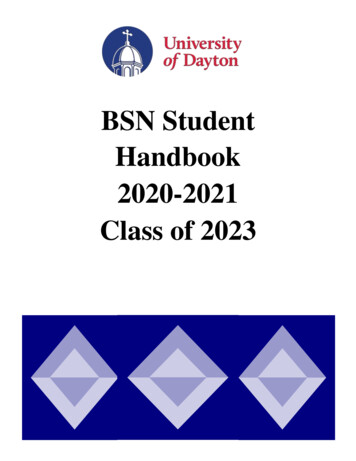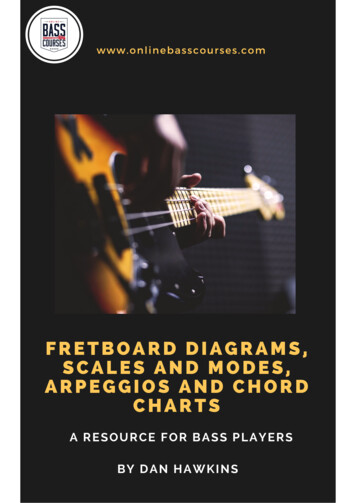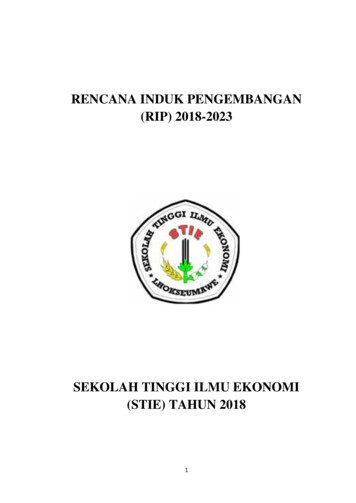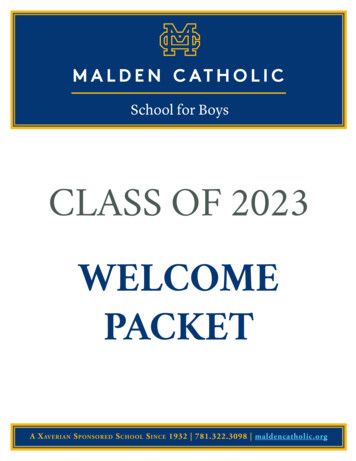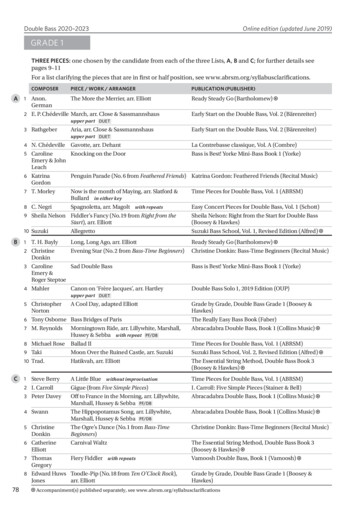
Transcription
Double Bass 2020–2023 Online edition (updated June 2019)GRADE 1THREE PIECES: one chosen by the candidate from each of the three Lists, A , B and C; for further details seepages 9–11For a list clarifying the pieces that are in first or half position, see E / WORK / ARRANGER1Anon.The More the Merrier, arr. ElliottGerman2 E. P. Chédeville March, arr. Close & SassmannshausPUBLICATION (PUBLISHER)Ready Steady Go (Bartholomew)Early Start on the Double Bass, Vol. 2 (Bärenreiter)upper part DUET3 RathgeberAria, arr. Close & SassmannshausEarly Start on the Double Bass, Vol. 2 (Bärenreiter)upper part DUET4 N. Chédeville5 CarolineGavotte, arr. DehantKnocking on the DoorEmery & JohnLeach6 KatrinaPenguin Parade (No. 6 from Feathered Friends)Gordon7 T. MorleyNow is the month of Maying, arr. Slatford &Bullard in either key8 C. NegriSpagnoletta, arr. Magolt with repeats9 Sheila Nelson Fiddler’s Fancy (No. 19 from Right from theStart), arr. Elliott10 SuzukiAllegrettoB1T. H. Bayly2 ChristineLong, Long Ago, arr. ElliottEvening Star (No. 2 from Bass-Time Beginners)La Contrebasse classique, Vol. A (Combre)Bass is Best! Yorke Mini-Bass Book 1 (Yorke)Katrina Gordon: Feathered Friends (Recital Music)Time Pieces for Double Bass, Vol. 1 (ABRSM)Easy Concert Pieces for Double Bass, Vol. 1 (Schott)Sheila Nelson: Right from the Start for Double Bass(Boosey & Hawkes)Suzuki Bass School, Vol. 1, Revised Edition (Alfred)Ready Steady Go (Bartholomew)Christine Donkin: Bass-Time Beginners (Recital Music)Donkin3 CarolineSad Double BassEmery &Roger Steptoe4 MahlerCanon on ‘Frère Jacques’, arr. HartleyBass is Best! Yorke Mini-Bass Book 1 (Yorke)Double Bass Solo 1, 2019 Edition (OUP)upper part DUET5 ChristopherCA Cool Day, adapted ElliottNorton6 Tony Osborne Bass Bridges of Paris7 M. ReynoldsMorningtown Ride, arr. Lillywhite, Marshall,Hussey & Sebba with repeat PF/DB8 Michael Rose Ballad II9 TakiMoon Over the Ruined Castle, arr. Suzuki10 Trad.Hatikvah, arr. ElliottGrade by Grade, Double Bass Grade 1 (Boosey &Hawkes)The Really Easy Bass Book (Faber)Abracadabra Double Bass, Book 1 (Collins Music)1Time Pieces for Double Bass, Vol. 1 (ABRSM)I. Carroll: Five Simple Pieces (Stainer & Bell)Abracadabra Double Bass, Book 1 (Collins Music)Steve Berry2 I. Carroll3 Peter Davey4 Swann5 ChristineA Little Blue without improvisationGigue (from Five Simple Pieces)Off to France in the Morning, arr. Lillywhite,Marshall, Hussey & Sebba PF/DBThe Hippopotamus Song, arr. Lillywhite,Marshall, Hussey & Sebba PF/DBThe Ogre’s Dance (No. 1 from Bass-TimeBeginners)Carnival WaltzDonkin6 CatherineElliott7 ThomasFiery Fiddler with repeatsGregory8 Edward Huws Toodle-Pip (No. 18 from Ten O’Clock Rock),Jonesarr. Elliott78Time Pieces for Double Bass, Vol. 1 (ABRSM)Suzuki Bass School, Vol. 2, Revised Edition (Alfred)The Essential String Method, Double Bass Book 3(Boosey & Hawkes)Abracadabra Double Bass, Book 1 (Collins Music)Christine Donkin: Bass-Time Beginners (Recital Music)The Essential String Method, Double Bass Book 3(Boosey & Hawkes)Vamoosh Double Bass, Book 1 (Vamoosh)Grade by Grade, Double Bass Grade 1 (Boosey &Hawkes)Accompaniment(s) published separately, see www.abrsm.org/syllabusclarifications
Double Bass 2020–2023 Grade 1Online edition (updated June 2019) COMPOSERPIECE / WORK / ARRANGERPUBLICATION (PUBLISHER)9 Tony Osborne And Y NotThe Really Easy Bass Book (Faber)The Really Easy Bass Book (Faber)10 Tony Osborne SambaSCALES AND ARPEGGIOS: from memory; for further details (including examples) see pages 11, 14–15 & 19Group 1 (first position) or Group 2 (half position), at candidate’s choice – the examiner will ask which Group/position GROUP 1RANGEREQUIREMENTSa 6thseparate bows or slurred (2 quavers to a bow), atexaminer’s choice;even notes or long tonic, at candidate’s choiceSCALESC, D majorsG majorA natural minor1 oct.ARPEGGIOSG majorA minor1 oct.separate bows;even notes GROUP 2RANGEREQUIREMENTSa 6thseparate bows or slurred (2 quavers to a bow), atexaminer’s choice;even notes or long tonic, at candidate’s choiceorSCALESC majorF, B - majorsA natural minor1 oct.ARPEGGIOSF, B - majorsA minor1 oct.separate bows;even notesSIGHT-READING: a short piece of previously unseen music; for further details see pages 12 & 20–21AURAL TESTS: administered by the examiner from the piano; for further details see pages 94 & 9579
Grades Initial–8BOWED STRING GRADES: requirements and informationThis syllabus is valid for 2020–2023.This section provides a summary of the most important points that teachers and candidates needto know when taking ABRSM graded bowed string exams. Further details, as well as admini strative information about the exams, are given in ABRSM’s Exam Regulations (available atwww.abrsm.org/examregulations) which should be read before making an exam booking.Changes in the 2020–2023 syllabusThere are two main changes in this syllabus: Initial Grade is introduced; this pre-Grade 1 exam follows the format of Grades 1–8 and isassessed using the same marking criteriaA string accompaniment option is offered for some pieces at Grades Initial–3.Entering for an examEligibility: There are nine grades of exam for each instrument. Candidates may be entered forany grade at any age and do not need to have taken other grade(s) on the same instrument.Candidates for a Grade 6, 7 or 8 exam must have already passed ABRSM Grade 5 (or above) inMusic Theory, Practical Musicianship or a solo Jazz instrument; for full details, including a listof accepted alternatives, see www.abrsm.org/prerequisite.Access: ABRSM is committed to providing all candidates with fair access to its assessmentsby putting in place access arrangements and reasonable adjustments. There is a range ofalternative tests and formats as well as guidelines for candidates with specific needs (see www.abrsm.org/specificneeds). Where a candidate’s needs are not covered by the guidelines, eachcase is considered individually. Further information is available from the Access Co-ordinator(accesscoordinator@abrsm.ac.uk).Exam booking: Details of exam dates, locations, fees and how to book an exam are availableonline at www.abrsm.org/exambooking.InstrumentsCandidates are required to perform on acoustic instruments (electric instruments are notallowed). Any size of instrument may be used; Viola candidates may play on a violin strungas a viola. Examiners apply the marking criteria (which include the assessment of pitch, toneand musical shaping) to assess musical outcomes without reference to the specific attributesof the instrument.8
Bowed String grades: requirements and informationElements of the examAll ABRSM graded bowed string exams consist of: three Pieces; Scales and arpeggios; Sightreading; and Aural tests. In all grades, marks are allocated as follows:Pieces: 123Scales and arpeggiosSight-readingAural testsTotal303030212118150Marking scheme: Exams are marked out of 150. 100 marks are required for a Pass, 120 for aMerit and 130 for a Distinction. Candidates do not need to pass each section to pass overall.See pp. 106–107 for the marking criteria used by examiners.PiecesMusicians learn to play an instrument to explore and perform repertoire, which is why piecesare at the core of the exam – candidates are asked to present three at each grade. The syllabusrepertoire is organised into three lists which explore different traditions and styles, datingfrom the Renaissance period to the present day.Choosing one piece from each list gives candidates the opportunity to play a balancedselection and demonstrate a range of skills. In this syllabus, the pieces are broadly groupedinto lists by the characteristics of the music: List A pieces are generally faster moving and require technical agilityList B pieces are more lyrical and invite expressive playingList C pieces reflect a wide variety of musical traditions, styles and characters.Most of the pieces require an accompaniment, as interacting with other musicians is animportant musical skill, but there are also opportunities to choose solo pieces and developconfidence with unaccompanied playing.We hope that by offering this variety in the syllabus, candidates will find music that inspiresthem and that they enjoy learning and performing.Programme planning: Candidates must choose one piece from each of the three lists (A, Band C)*. In the exam, candidates should tell the examiner which pieces they are performing,and they are welcome to use the form on p. 109 for this.Every effort has been made to feature a broad range of repertoire to suit and appeal tocandidates of different ages, backgrounds and interests. Certain pieces may not be suitable forevery candidate for technical reasons or because of wider context (historical, cultural, subjectmatter of the larger work from which it is drawn, lyrics if an arrangement of a song etc.). Piecesshould be carefully considered for their appropriateness to each individual, which may needconsultation between teachers and parents/guardians. Teachers and parents/guardians shouldalso exercise caution when allowing younger candidates to research pieces online: www.nspcc.org.uk/onlinesafety.* Grade 8 Violin candidates must choose at least one accompanied piece (there are solo pieces on all three lists).9
Bowed String grades: requirements and informationAccompaniment: A live piano or string (where the option is listed) accompaniment is requiredfor all pieces, except those which are published as studies or unaccompanied works (these aremarked SOLO in the syllabus list).At Grades Initial–3, candidates may perform some or all of their pieces with a string accompaniment. Pieces that are published as duets (or with string accompaniment only) are marked DUETin the syllabus list. Pieces that are published with piano and string accompaniment options aremarked PF/VN , PF/VA , PF/VC , or PF/DB in the syllabus list, and may be performed with eitheraccompaniment in the exam.Candidates must provide their own accompanist(s), who can only be in the exam room whileaccompanying. The candidate’s teacher may accompany (examiners will not). If necessary,an accompanist may simplify any part of the accompaniment, as long as the result is musical.Recorded accompaniments are not allowed.Exam music & editions: Wherever the syllabus includes an arrangement or transcription(appearing as ‘arr.’ or ‘trans.’ in the syllabus list), the edition listed in the syllabus must be usedin the exam. For all other pieces, editions are listed for guidance only and candidates may useany edition of their choice (in- or out-of-print or downloadable). Information on sourcing exammusic is given on p. 13.Interpreting the score: Printed editorial suggestions such as fingering, bowing, metronomemarks, realisation of ornaments etc. do not need to be strictly observed. Whether the piececontains musical indications or not, candidates are encouraged to interpret the score in amusical and stylistic way. Examiners’ marking will be determined by how control of pitch, time,tone, shape and performance contributes to the overall musical outcome.Vibrato: The use and control of vibrato, and its effect on tone and shape, will be taken intoaccount by examiners, who will be assessing the overall musical outcome. Pieces that areheavily reliant on vibrato for their full musical effect tend not to appear in the syllabus beforearound Grade 5.Repeats: Unless the syllabus specifies differently, all da capo and dal segno indications shouldbe followed but other repeats (including first-time bars) should not be played unless they arevery short (i.e. a few bars).Cadenzas & tuttis: Cadenzas should not be played unless the syllabus specifies differently.Accompanists should cut lengthy orchestral tutti sections.Performing from memory: Candidates may perform any of their pieces from memory; if doingso, they must make sure that a copy of the music is available for the examiner to refer to. Noextra marks are awarded for playing from memory.Page-turns: Examiners will be understanding if a page-turn causes a lack of continuity during apiece, and this will not affect the marking. Candidates (and accompanists) may use an extra copyof the music or a photocopy of a section of the piece (but see ‘Photocopies’ on p. 11) to help withpage-turns. Candidates and accompanists at Grades 6–8 may bring a page-turner to the examif there is no solution to a particularly awkward page-turn (prior permission is not required;the turner may be the candidate’s teacher). Examiners are unable to help with page-turning.10
Bowed String grades: requirements and informationPhotocopies: Performing from unauthorised photocopies (or other kinds of copies) of copyrighteditions is not allowed. ABRSM may withhold the exam result where it has evidence of an illegalcopy (or copies) being used. In the UK, copies may be used in certain limited circumstances –for full details, see the MPA’s Code of Fair Practice at www.mpaonline.org.uk. In all other cases,application should be made to the copyright holder before any copy is made, and evidence ofpermission should be brought to the exam.Scales and arpeggiosPlaying scales and arpeggios is important for building strong technical skills such as reliablefinger movement, hand position, co-ordination and fingerboard fluency. It also helps todevelop tone, pitch and interval awareness, and familiarity with keys and their relatedpatterns. This leads to greater confidence and security when sight-reading, learning newpieces and performing – from a score or from memory, as a solo musician or with others.Memory: All requirements should be played from memory.Range: All requirements should be played from the lowest possible tonic/starting note unlessthe syllabus specifies differently. They should ascend and descend according to the specifiedrange (and pattern).Rhythm: For most major and minor scales (and double-stop scales in parallel sixths/octaves)candidates may choose between two rhythm patterns: even n
Abracadabra Double Bass, Book 1 (Collins Music) 5 Christine Donkin The Ogre’s Dance (No. 1 from Bass-Time Beginners) Christine Donkin: Bass-Time Beginners (Recital Music) 6 Catherine Elliott Carnival Waltz The Essential String Method, Double Bass Book 3 (Boosey & Hawkes) 7 Thomas Gregory Fiery Fiddler with repeats Vamoosh Double Bass, Book 1 (Vamoosh)
